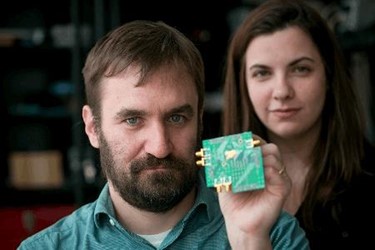Cornell Engineers Build Two-Way Software-Defined Radio On A Single Chip
By Jof Enriquez,
Follow me on Twitter @jofenriq

Researchers at the School of Electrical and Computer Engineering at Cornell University have built a software-defined radio (SDR) transceiver that is capable of transmitting and receiving a radio signal on a single chip, which presents a new way to build wireless communication circuits.
Typically, a single chip communication device requires placing a significant filter between transmit (TX) and receive circuits (RX) to enable communication.
“Your transmit signal is 1014 times stronger than your receive signal,” said Alyosha Molnar, associate professor of electrical and computer engineering (ECE), in an article published in the Cornell Chronicle. “That’s 100 trillion times stronger – that’s a really hard problem.”
Drawing upon certain concepts demonstrated by a previous project by Stanford University researchers, who devised a way for a transmitter to filter its own transmission, Cornell researchers used a method called frequency division duplex (FDD) to create a new type of transmitter, consisting of six subtransmitters all hooked into an artificial transmission line.
Each transmitter sends a signal at regular intervals, and their individually weighted outputs are programmed so that they combine to produce a radio frequency signal in the forward direction, at the antenna port, while canceling out at the receive port, according to the Cornell engineers.
“You put the antenna at one end and the amplified signal goes out the antenna, and you put the receiver at the other end and that’s where the nulling happens,” said Molnar. “Your receiver sees the antenna through this wire, the transmission line, but it doesn’t see the transmit signal because it’s canceling itself out at that end.”
They provided a more in-depth explanation in, "A Wideband Fully Integrated Software-Defined Transceiver for FDD and TDD Operation," published online in IEEE's Journal of Solid-State Circuits. Cornell's custom-built circuit "cancels the transmitted signal at a reverse RX port through destructive interference while adding signal constructively at a forward TX port. We pair the distributed transmitter with a receiver-tracking PA degeneration technique to suppress the injected noise from TX circuits in the RX band. The system does not require off-chip filters or circulators, but still achieves both SDR flexibility and both FDD and time division duplex function. Measurements from the transceiver implemented in 65-nm CMOS show a frequency tuning range of 0.3-1.6 GHz with TX-RX isolation >23 dB and transmitted power up to 19 dBm."
Unlike the Stanford team's transmitter, Cornell's transmitter is capable of handling a wide range of frequencies by digitally controlling signal separation, instead of installing additional filters for every band to accommodate multiple frequencies. Also, users need simply to download software for updates, rather than complete hardware replacements for software-defined radios with Cornell’s transmitter.
Molnar was assisted in this research by graduate student Hazal Yüksel, Changhyuk Lee, Ph.D. ’14, and doctoral students Zachariah Boynton and Thomas Tapen. The Defense Advanced Research Projects Agency (DARPA) supported their work financially.
